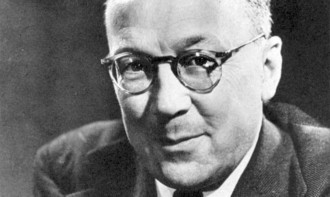The “fantastic” statue which will be Brechin’s first piece of public art is a step closer to going on show.
Enthusiasts of the Watson-Watt Society this week received planning approval to site a bronze of the town son known as the ‘father of radar’ on the corner of St Ninian’s Square, and the delighted group hopes to be able to put the final pieces of the funding jigsaw in place soon.
Scots sculptor Alan Herriot’s completed bronze of Sir Robert Watson-Watt is in storage in Edinburgh, ready to be sited on the plinth in the square which Angus development standards committee members gave unanimous approval for this week.
The impressive statue of the man who led the team that developed radar for the defence of the nation in the Second World War will be sited in the north-east corner of St Ninian’s Square.
Councillor and committee member Mairi Evans said: “The Watson-Watt Society have worked tirelessly for years for this statue to happen and I think it will be a fantastic addition to Brechin.
“It will build the profile of Brechin and hopefully attract more visitors to celebrate this internationally-renowned figure.”
Montrose councillor Bill Duff added: “Speaking as one who trained as a scientist, I think it is great to have a statue honouring such an important figure and hopefully it may inspire future generations.”
Brian Mitchell of the society said: “We’re delighted to receive the planning approval and hope to be able to confirm soon the schedule for the statue being put in place.”
Watson-Watt was born in Brechin’s Union Street and graduated with a BSc in Engineering in 1912 from University College, Dundee, then part of St Andrews University.
He earned a knighthood for his work in developing the early-warning radar that allowed pilots to detect and intercept attacking German aircraft during the Battle of Britain.
Watson-Watt spent many years in the USA and Canada, but later returned to Scotland and died in Inverness in 1973, aged 81. His grave is in Pitlochry.
